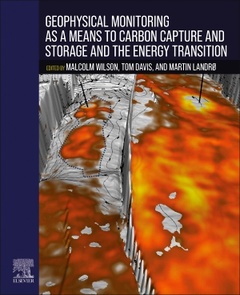Description
Geophysics and the Energy Transition
Coordinators: Davis Tom, Wilson Malcolm, Landro Martin
Language: English
Subject for Geophysics and the Energy Transition:
475 p. · 19x23.3 cm · Paperback
Description
/li>Contents
/li>Biography
/li>Comment
/li>
Geophysical Monitoring as A Means to Carbon Capture and Storage and the Energy Transition involves four sections: What is the Energy Transition and why storage so important; selecting sites for storage; advanced monitoring technology; and moving forward to integrating Carbon Capture and Storage (CCS) within the Energy Transition. To provide the public and others with the confidence to move forward with a structured and cost-effective energy transition, this book provides the necessary evidence that we can store CO2 safely and effectively and use this as a significant component of the energy transition. The book is written by experts in the field who have practiced the science and engineering associated with subsurface CCS for years. CCS is an integral component of the new energy transition. Science, engineering, and technology applications are important for site selection, characterization, and monitoring to assure safe storage in the subsurface and energy sustainability in the future.
1. Introduction to the Energy Transition
2. Technologies Involved in the Energy Transition
3. Preventing CO2 from Fossil Fuels from Reaching the Atmosphere
4. Subsurface CCS
Section 2: Selecting Sites and Ensuring Effective Storage
5. An Engineering Perspective on the Need for Effective Management of Subsurface Carbon Storage
6. Rock Physics for Subsurface CCS Via Laboratory and Field Scale Data
7. The Geochemistry of Geosequestration
8. The Geomechanics of Subsurface CCS
9. Geophysical Technologies for CO2 Monitoring
10. CO2 and Hydrogen Storage: Field Studies
Section 3: Site Studies of Advanced Technology and Broad Application of These Technologies
11. Weyburn Field, Williston Basin: Case Study
12. Vacuum Field, Permian Basin: Case Study
13. Northern Lights Project, Norway: CCS in Industrial Transformation
14. Aquistore Project, Canada: Case Study
15. New CCS projects in the Williston Basin, North Dakota, Montana: Case Study
Section 4: Moving Forward
16. Expanding CCS opportunities Into Hallow Zones
17. Storage and Monitoring in Volcanic Zones
18. Lessons learned from Sleipner, Algeria, Snovhit, Ketzin, Quest, Decatur, Barendrecht, UK initiatives, Germany Oxyfuel, Kemper Co. Gasification.
19. Evolution of the Knowledge Base and Lessons Learned for Future CCS Subsurface Projects
20. Future Challenges and Opportunities for Geoscientists and Engineers
Malcolm was the Director of the Office of Energy and Environment at the University of Regina from 2000 - 2010, prior to which he worked for Saskatchewan Energy and Mines for twenty years. He was instrumental in the creation of the IEAGHG Weyburn-Midale CO2 Monitoring and Storage Project, a world recognised CO2 storage research project, including editing the final report of phase one. In the fall of 2012, another PTRC project was responsible for an historic event, the drilling of the deepest well in Saskatchewan’s history: 3396 metres. Malcolm was a member of Working Group III of the Intergovernmental Panel on Climate Change (IPCC), the scientific team awarded the 2007 Nobel Peace Prize jointly with Al Gore, and for which Malcolm was a lead author on the IPCC Special Report on Carbon Dioxide Capture and Storage. He also founded the Prairie Adaptation Research Collaborative (PARC), serving as its first head.
In 2009, Malcolm was awarded the University of Saskatchewan Alumni Award of Achievement for outstanding contributions to profession, community and the University of Saskatchewan. In the same year, Saskatchewan Business Magazine named him one of Saskatchewan's ten most infl
- Presents an overview of available technology, along with specific applications and scenarios in which to use the technology
- Features case studies to provide practical applications for geoscientists and engineers in the energy industry
- Includes an overview of the history of Carbon Capture and Storage (CCS) to provide context for energy transition




